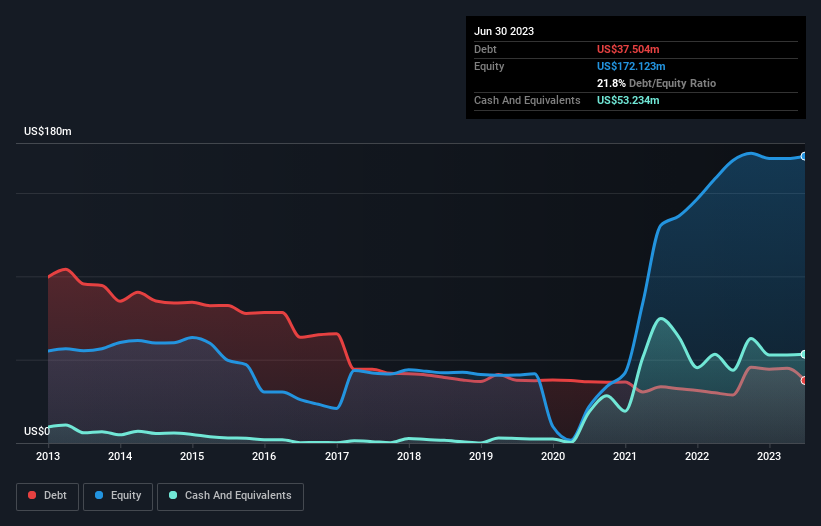- United States
- /
- Marine and Shipping
- /
- NasdaqCM:GLBS
These 4 Measures Indicate That Globus Maritime (NASDAQ:GLBS) Is Using Debt Extensively

The external fund manager backed by Berkshire Hathaway's Charlie Munger, Li Lu, makes no bones about it when he says 'The biggest investment risk is not the volatility of prices, but whether you will suffer a permanent loss of capital.' When we think about how risky a company is, we always like to look at its use of debt, since debt overload can lead to ruin. We note that Globus Maritime Limited (NASDAQ:GLBS) does have debt on its balance sheet. But the real question is whether this debt is making the company risky.
What Risk Does Debt Bring?
Generally speaking, debt only becomes a real problem when a company can't easily pay it off, either by raising capital or with its own cash flow. In the worst case scenario, a company can go bankrupt if it cannot pay its creditors. While that is not too common, we often do see indebted companies permanently diluting shareholders because lenders force them to raise capital at a distressed price. By replacing dilution, though, debt can be an extremely good tool for businesses that need capital to invest in growth at high rates of return. When we examine debt levels, we first consider both cash and debt levels, together.
View our latest analysis for Globus Maritime
What Is Globus Maritime's Debt?
The image below, which you can click on for greater detail, shows that at June 2023 Globus Maritime had debt of US$37.5m, up from US$28.9m in one year. However, its balance sheet shows it holds US$53.2m in cash, so it actually has US$15.7m net cash.

A Look At Globus Maritime's Liabilities
Zooming in on the latest balance sheet data, we can see that Globus Maritime had liabilities of US$13.5m due within 12 months and liabilities of US$31.7m due beyond that. On the other hand, it had cash of US$53.2m and US$611.0k worth of receivables due within a year. So it actually has US$8.65m more liquid assets than total liabilities.
It's good to see that Globus Maritime has plenty of liquidity on its balance sheet, suggesting conservative management of liabilities. Given it has easily adequate short term liquidity, we don't think it will have any issues with its lenders. Succinctly put, Globus Maritime boasts net cash, so it's fair to say it does not have a heavy debt load!
Shareholders should be aware that Globus Maritime's EBIT was down 100% last year. If that earnings trend continues then paying off its debt will be about as easy as herding cats on to a roller coaster. When analysing debt levels, the balance sheet is the obvious place to start. But ultimately the future profitability of the business will decide if Globus Maritime can strengthen its balance sheet over time. So if you want to see what the professionals think, you might find this free report on analyst profit forecasts to be interesting.
Finally, a company can only pay off debt with cold hard cash, not accounting profits. Globus Maritime may have net cash on the balance sheet, but it is still interesting to look at how well the business converts its earnings before interest and tax (EBIT) to free cash flow, because that will influence both its need for, and its capacity to manage debt. During the last two years, Globus Maritime burned a lot of cash. While that may be a result of expenditure for growth, it does make the debt far more risky.
Summing Up
While we empathize with investors who find debt concerning, you should keep in mind that Globus Maritime has net cash of US$15.7m, as well as more liquid assets than liabilities. So while Globus Maritime does not have a great balance sheet, it's certainly not too bad. The balance sheet is clearly the area to focus on when you are analysing debt. However, not all investment risk resides within the balance sheet - far from it. For example, we've discovered 5 warning signs for Globus Maritime (1 shouldn't be ignored!) that you should be aware of before investing here.
At the end of the day, it's often better to focus on companies that are free from net debt. You can access our special list of such companies (all with a track record of profit growth). It's free.
New: Manage All Your Stock Portfolios in One Place
We've created the ultimate portfolio companion for stock investors, and it's free.
• Connect an unlimited number of Portfolios and see your total in one currency
• Be alerted to new Warning Signs or Risks via email or mobile
• Track the Fair Value of your stocks
Have feedback on this article? Concerned about the content? Get in touch with us directly. Alternatively, email editorial-team (at) simplywallst.com.
This article by Simply Wall St is general in nature. We provide commentary based on historical data and analyst forecasts only using an unbiased methodology and our articles are not intended to be financial advice. It does not constitute a recommendation to buy or sell any stock, and does not take account of your objectives, or your financial situation. We aim to bring you long-term focused analysis driven by fundamental data. Note that our analysis may not factor in the latest price-sensitive company announcements or qualitative material. Simply Wall St has no position in any stocks mentioned.
About NasdaqCM:GLBS
Globus Maritime
An integrated dry bulk shipping company, provides marine transportation services worldwide.
High growth potential with proven track record.
Similar Companies
Market Insights
Community Narratives


